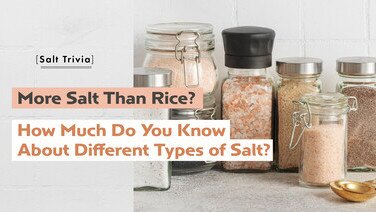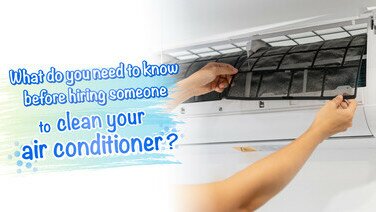Principle of UVC Disinfection
Ultraviolet (UV) radiation can be divided into 3 categories, including long-wavelength ultraviolet (UVA), medium-wavelength ultraviolet (UVB), and short-wavelength ultraviolet (UVC). The shorter the wavelength, the higher the energy. The UV radiation emitted by portable UV disinfection devices is UVC. The UVC that comes from the sun cannot reach the Earth, but some artificial light sources such as welding, disinfection lamps, etc. can produce UVC.
Long-wavelength ultraviolet (UVA) | Medium-wavelength ultraviolet (UVB) | Short-wavelength ultraviolet (UVC) | |
Wavelength | 315-400nm | 280-315nm | 100-280nm |
Characteristics | It can pass through the ozone layer and reach Earth, transmit through glass windows to indoors and vehicles, causing body tanning. Over-exposure may cause skin deterioration and produce wrinkles. Severe exposure may lead to skin cancer. | It is mostly absorbed by the ozone layer and only a small amount can reach Earth. It damages the skin’s DNA and causes sunburn, where severe exposure may lead to skin cancer. | It is fully absorbed by the ozone layer and cannot reach Earth. |
According to studies, UVC with a wavelength of less than 280 nm can destroy the DNA or RNA molecular structure of bacteria and viruses, causing them to break down, losing the ability to reproduce and infect, therefore achieving the effect of sterilisation and disinfection. UVC disinfection is commonly used to inhibit the bacteria and viruses found in water, air, and the surface of objects.
Choosing Products
1. Safety
Prolonged exposure to UV radiation may cause damage to the skin and eyes, for instance, skin deterioration, increasing the risk of skin cancer and cataracts. Although the penetration depth of UVC is low and most of the UVC will be absorbed by the dead skin, however, if the body is in contact with UVC for a long time or at a high dosage, it can cause photokeratitis (similar to snow blindness) or cause redness and swelling or ulceration of the skin.
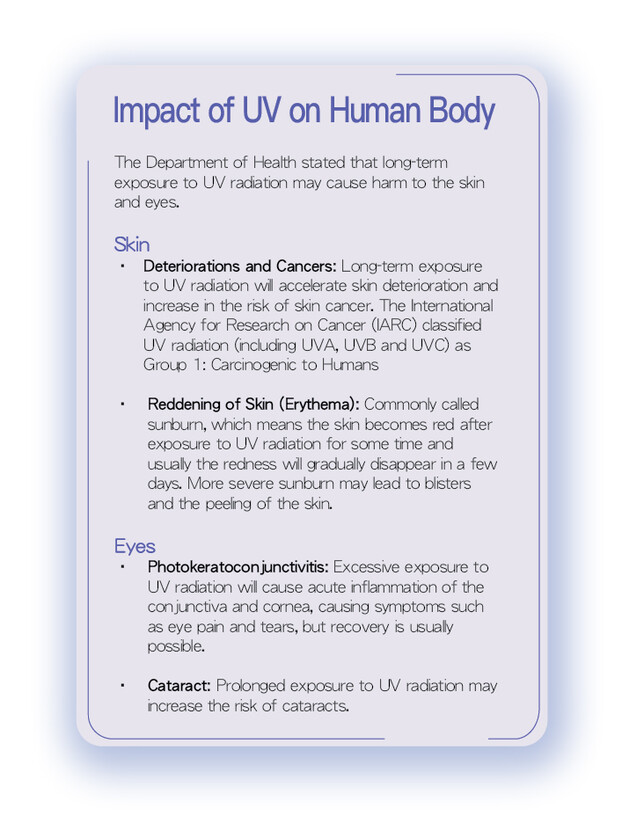
Generally, accidental exposure to excessive UVC may have a short-term effect on the body, and there is no evidence showing that the use of UVC disinfection could increase the risk of skin cancer. However, when using UVC disinfection, it is still necessary to pay attention to the acute physical problems caused by short-term excessive exposure and avoid direct irradiation of the body, especially the eyes. Therefore, when choosing a portable UV disinfection device, its safety design is one of the important considerations.
Handheld UV Disinfection Devices Less Safe
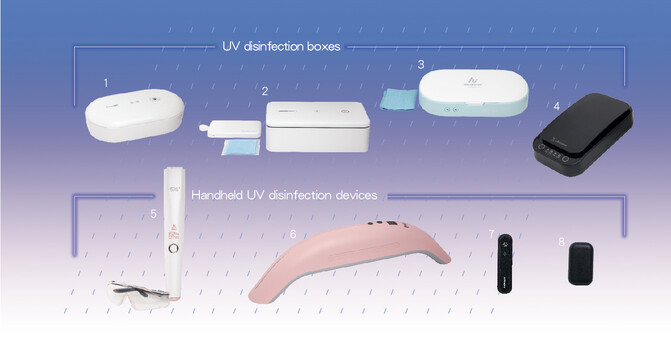
The Council tested 8 of the common portable UVC disinfection devices on the market, of which 3 were box-type with enclosed designs, 4 were handheld designs, and 1 was a box design, but it can also be used in handheld mode. The results showed that the overall safety performance of the handheld disinfection devices is poor:
UV Irradiation | Measure the irradiance of UV radiation at the periphery of each model to assess whether the models may cause hazard to humans. For models tested in an enclosed environment (activated with lids closed), no UV radiation was detected in the surrounding area under normal use. However, when the lid of the box was accidentally opened during the disinfection process, the UV lamps of some models were still on, and the measured irradiance of UV radiation exceeded the upper limit of the standard. The measured irradiance of UV radiation of the handheld models was found to exceed the upper limit standard. |
Photobiological Safety | To assess the hazard level of the emitted UV radiation from the models to skin and eyes, the Council also measured the effective irradiance at a distance of 200mm from the models and classified them into exempt, low, medium, and high-risk levels according to the allowable limits specified in the standard. The results showed that 3 handheld models and 1 box model with handheld mode were rated at high-risk level which means that burns and injuries to the skin and eyes may result from a short period of exposure to UV radiation emitted from these products. The other handheld model and 1 box-type model were rated at moderate risk, which may cause discomfort or burning reactions to the skin and eyes when exposed to the UV radiation from these products. |
Therefore, when selecting products, consumers should pay attention to their safety features:
UV Position | The UV lamp of the box model is generally located within the box enclosure, and in normal use, the user’s eyes and skin will not have access to the UV radiation emitted from the lamp. |
Safety Protection Sensor | All handheld models have a safety sensor, and when the device is tilted up or tilted sideways to a specific angle, its UV lamp will automatically turn off to avoid the user or the surrounding crowd from being exposed to UV. |
Preset Operating Time | The preset operation time of 4 box models and 1 handheld model is lower than the permissible time of exposure (the actual hazard posed by UV exposure is determined by its wavelength and intensity, and the time of exposure is also critical. The permissible time of exposure varies depending on the amount of effective irradiation and exposure limits. 1 handheld model allows the user to set the operating time manually (5, 10 and 15 minutes respectively), however, the settable operation time is much higher than its permissible time of exposure (30 seconds). |
2. Disinfection Efficacy
In addition to the safety of the product, the disinfection efficacy of the devices is also very important. Tests showed that most of the models had good bactericidal performance, but their ability to suppress viruses varies:
Bactericidal Performance | Staphylococcus aureus and Klebsiella pneumoniae were used as the testing bacteria of the test. The results showed that 3 box models and 1 handheld model had an average kill rate of the 2 testing bacteria models of 99.9% or above, among which 1 model if operated with a longer operation time (30 minutes), could reach an average kill rate of over 99.99%. However, the performances of the other 3 models were slightly inferior, and the average kill rate of the 2 testing bacteria ranged from 97.52% to 98.93%, which was slightly lower than claimed. |
Virucidal Performance | Influenza A H1N1 was used as the testing virus. 2 handheld models had an outstanding performance in eliminating the testing virus, at a specific test distance and time, the viral infectivity was reduced by more than 99.99%. However, the performance of the 4 models was relatively inferior, and the infectivity of the testing virus was only inhibited by an average of 14.97% to 87.01%, and the virucidal performance was unsatisfactory. |
Product Usage Guide
If you would like to use the products safely and effectively, view the following video with detailed consumer tips!
https://www.youtube.com/watch?v=BPbmOdCev7A
Avoid Contact with UV Rays | The UV radiation emitted by the product shall not reach the eyes and skin under any circumstances, especially when using handheld type devices. Both the users and the surrounding crowd must keep away from the UV light source and avoid staring at the light source. |
Avoid Children from Contact | Products should be placed out of reach from children to prevent them from playing with these products and pointing the UV radiation towards themselves or their playmates’ eyes and skin, causing accidents. |
Location of UV Irradiation on Objects | UVC has a low penetration depth and cannot penetrate through solid objects. Most UVC will be absorbed by plastic and glass, so it can only be used for surface disinfection. If the objects overlap, the hidden area cannot be disinfected by UVC.
Simultaneously, when using a handheld disinfection device to disinfect an object with a large surface area (such as computer keyboards, tablets, door handles, etc.), with the need to disinfect each small area by irradiation, there are chances of misses. The user may not have enough patience and only casually sweep the disinfection device over the surface of the object, in which the irradiation period is insufficient, or the distance is not close enough to achieve complete disinfection. |
Use on Smooth, Non-porous Surfaces | UVC disinfects on smooth and non-porous surfaces achieves a better disinfection performance. Bacteria and viruses may hide in gaps or in between fibres, they cannot be directly exposed to UVC. If UVC disinfection technology is applied to some objects with rough or porous surfaces, or objects with dirt, grease, skin dandruff and other pollutants on the surface, the disinfection efficacy will also be relatively low. When using such products to disinfect objects with uneven surfaces, it is necessary to place the device as close to the objects to be disinfected as practicable and keep it for a certain period of time to allow better disinfection performance. |
Ultraviolet Rays Accelerate the Deterioration of Plastics | Not all objects are suitable for disinfection by UVC, such as plastic products, especially polypropylene (PP), low-density polyethylene (LDPE), rubber etc. If they are exposed to UVC for a long time, the deterioration of the material will be sped up, resulting in deformation, brittleness, discolouration and so on. UV rays may also cause colour changes on the surface of wall paint, photos, clothing, fabrics, and other surfaces. In addition, consumers should also avoid using direct UVC lights on plants so as not to affect their growth. |
Beware of Lifetime of Lamps | When the product has been used for a long time, the intensity of the UV lamp may not be strong for disinfection, so consumers should pay heed to whether the product information indicates the lifetime of the UV lamp. Users should also regularly clean the dirt on the surface of the UV lamp or LED so as not to affect its intensity. |
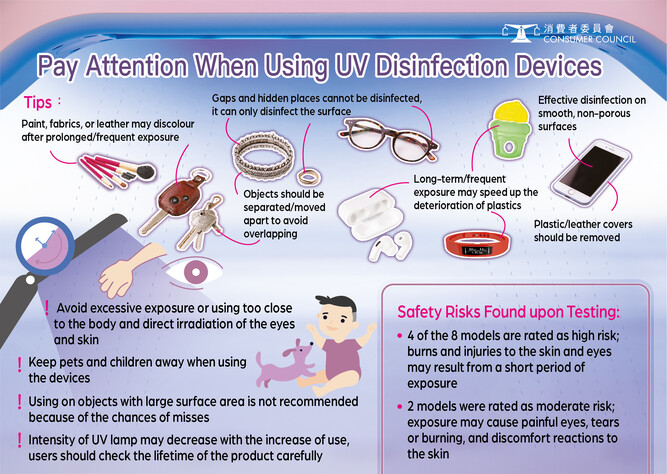
In summary, the Council recommends that consumers should only treat the portable UV disinfection device as an aid of disinfection and should not over rely on their disinfection efficacy. Improper use of such products is more likely to pose a potential hazard to the skin and eyes. In fact, it is fast and effective to use diluted bleach or alcohol at a concentration of about 75% to disinfect frequently used objects and there is no fear of missing any gaps in disinfection. Proper hand washing and the use of alcohol-based hand sanitisers after touching public objects are also effective measures to prevent the spread of viruses.
To find out the best UV disinfection, download the 532 issue of CHOICE Monthly Magazine: ‘Half of Portable UV Disinfection Device at High Risk; Beware of Damage to Skin and Eyes' (Chinese version only).
Extended Reading: Latest Summary on Effectiveness of Anti-epidemic Tools
Although new COVID-19 vaccines have been introduced, the pandemic has not completely disappeared, and with the emergence of mutant viruses, we must always be vigilant. Read ‘Adapting to New Normal: Latest Summary on Effectiveness of 3 Anti-epidemic Tools’ (Chinese version only) now to find out which anti-epidemic products on the market can effectively protect yourselves.


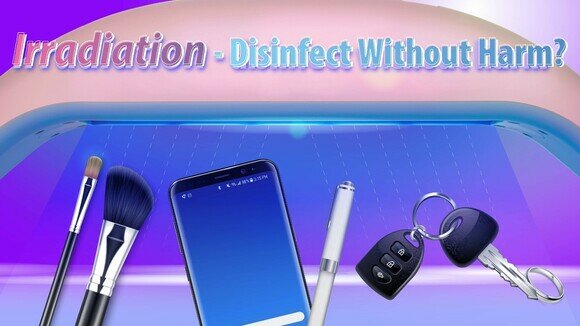
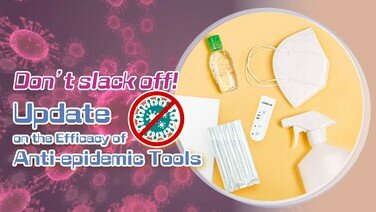




![[Baby Snacks Guide] Who Says Snacks Can’t Be Healthy?](/f/guide_detail/415742/376c212/bb%20snack.jpg)
